MRS/MRSI Acquisition
Oral
Spectroscopy & Non-Proton MR
Thursday, 21 June 2018
| S05 |
08:00 - 10:00 |
Moderators: Borjan Gagoski, Zhong Chen |
08:00
|
1057.
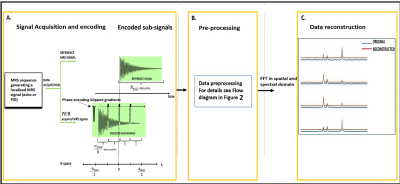 |
 Reduction of Acquisition time by Partition of the sIgnal Decay in Spectroscopic Imaging (RAPID-SI) technique: Preliminary In-vivo results and comparison with CSI. Reduction of Acquisition time by Partition of the sIgnal Decay in Spectroscopic Imaging (RAPID-SI) technique: Preliminary In-vivo results and comparison with CSI.
Sourav Bhaduri, Patricia Clement, Eric Achten, Hacene Serrai
We describe the development of the RAPID-SI technique and its implementation on a 3 T Siemens scanner. In-vivo studies demonstrate the performance of this technique in terms of acquisition time, signal-to-noise ratio, and data analysis. The results are compared to the CSI technique. Compared to CSI, RAPID reduces the acquisition time by a factor of R and provides accurate quantification results. The SNR of RAPID at the acquisition level is lower by √R and increased by data pre-processing. Quantification results of RAPID-SI are comparable to the CSI ones. The study shows that RAPID-SI provides accurate metabolite quantification results while significantly reducing acquisition time in obtaining MRSI data similar to CSI in terms of resolution and sensitivity.
|
08:12
 |
1058.
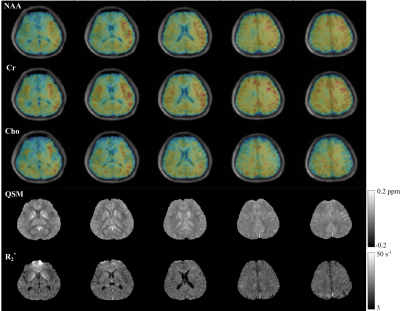 |
 Further Accelerating SPICE for Ultrafast MRSI Using Learned Spectral Features Further Accelerating SPICE for Ultrafast MRSI Using Learned Spectral Features
Fan Lam, Yudu Li, Rong Guo, Bryan Clifford, Xi Peng, Zhi-Pei Liang
This work presents a new method to incorporate machine learning into SPICE (SPectroscopic Imaging by exploiting spatiospectral CorrElation) to further enhance its data acquisition speeds. The proposed method exploits the significant amount of prior knowledge about the spectral variations of biological tissues, e.g., molecular composition and resonance structures, by devising a novel strategy to learn the molecule-specific spectral features from training data, and incorporating the learned features into a subspace representation of the desired spatiospectral distribution for a general MRSI study. Impressive results have been produced by the proposed method from 1H-MRSI of the brain without any suppression pulses.
|
08:24
|
1059.
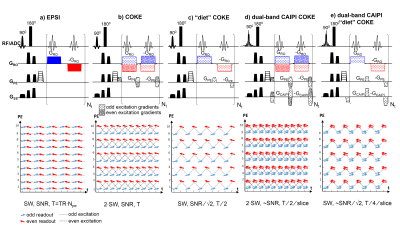 |
 Combining multi-band slice selection with COKE (COherent K-t-space EPSI) for accelerated spectral imaging Combining multi-band slice selection with COKE (COherent K-t-space EPSI) for accelerated spectral imaging
Rita Schmidt, Amir Seginer, Assaf Tal
One of the powerful techniques for faster spectroscopic imaging acquisition is so called proton echo planar spectroscopic imaging (EPSI). An alternative method, which we here term COKE (COherent K-t space EPSI), relies on interleaving “blipped” PE gradients in between readouts to produce coherent phase between the k-t space lines. COKE enables to double the SW in comparison to EPSI or to halve the acquisition duration. We designed a sequence that integrates a multi-band CAIPIRINHA with COKE acquisition for faster spectroscopic imaging. This was demonstrated in both phantoms and in-vivo.
|
08:36
|
1060.
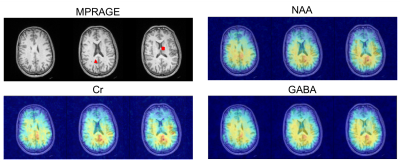 |
 MEGA-SPICE: A subspace-based approach to high-resolution spectral edited MRSI MEGA-SPICE: A subspace-based approach to high-resolution spectral edited MRSI
Chao Ma, Paul Han, Shuang Hu, Georges El Fakhri
Spectral edited MRS/MRSI is a powerful tool to detect metabolites with J-coupled spins (e.g., GABA and 2-HG) that are otherwise overlapped with other high concentration metabolites (e.g., Cho and Cr). Compared to conventional MRSI, it is even more challenging to achieve high-resolution spectral edited MRSI because of lower metabolite concentration and less time-efficient spatial-spectral encoding. A subspace-based approach, called SPICE (SPectroscopic Imaging by exploiting spatiospectral CorrElation), has been proposed for high-resolution MRSI, producing 3D MRSI images at 3 mm isotropic resolution within 10 mins. We present here a method, termed MEGA-SPICE, for accelerated high-resolution spectral edited MRSI, which is enabled by spectral editing using MEGA pulses and subspace-based data acquisition and processing strategies.
|
08:48
|
1061.
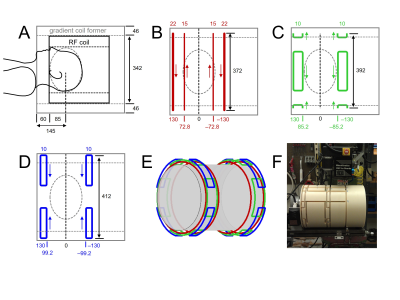 |
 Elliptical Localization with Pulsed Second-Order Fields (ECLIPSE) for Robust Lipid Suppression in Proton MRSI Elliptical Localization with Pulsed Second-Order Fields (ECLIPSE) for Robust Lipid Suppression in Proton MRSI
Robin de Graaf, Peter Brown, Henk De Feyter, Scott McIntyre, Terence Nixon
Proton MRSI has great clinical potential for metabolic mapping of healthy and pathological human brain. However, technical challenges related to poor spectral quality caused by magnetic field inhomogeneity, limited RF transmit power and incomplete lipid suppression have dampened the utility of MRSI. Here a novel method for lipid suppression is presented based on localization of an elliptical region-of-interest using pulsed second-order magnetic fields. A high-amplitude gradient setup was designed and constructed, containing coils to generate Z2, X2Y2 and XY magnetic fields. Simulations, phantom MRI and MRSI on human brain in vivo demonstrate robust localization and suppression of extracranial lipids.
|
09:00
|
1062.
 |
 Dynamically Switched B0 Field Control for Separate Optimization of Tailored Volume Lipid Suppression and B0 Homogeneity for Brain Chemical Shift Imaging at 3T using Multi-Coil Shim Array Dynamically Switched B0 Field Control for Separate Optimization of Tailored Volume Lipid Suppression and B0 Homogeneity for Brain Chemical Shift Imaging at 3T using Multi-Coil Shim Array
Nicolas Arango, Jason Stockman, Bernhard Strasser, Borjan Gagoski, Ovidiu Andronesi, Lawrence Wald, Jacob White, Elfar Adalsteinsson
A rapidly reconfigurable 32-channel local-multi-coil-shim-array is used to both enhance lipid suppression and narrow metabolite linewidth in chemical-shift imaging of the brain. Using in-situ optimization, the array is first configured to widen the spectral gap between spatially separate lipid and metabolite regions, to improve lipid-surpressing inversion, and then reconfigured for field homogeneity, to narrow metabolite linewidth during readout. For 2cm thick brain slab, using the dynamically-reconfigured array reduced lipid contamination by 24.5%, reduced linewidth by 34%, and increased well-imaged brain area by 38% over static 2nd order shimming
|
09:12
|
1063.
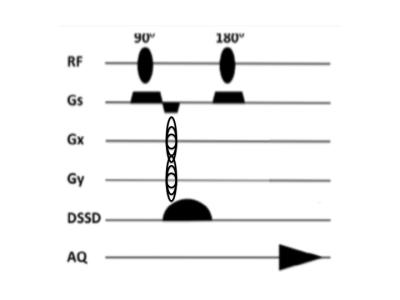 |
 Dynamic Spatially Selective Dephasing for Outer Volume Suppression Dynamic Spatially Selective Dephasing for Outer Volume Suppression
Jing-Huei Lee, Jullie Pan, Hoby Hetherington
A novel dynamic spatially selective dephasing (DSSD) for outer volume suppression (OVS) is introduced. This technique uses high-order shim pulses to accomplish OVS by creating a low and high field gradient within and outside of region of interest. The effectiveness of DSSD is investigated with phantom and human using an 8-channel parallel transmit 7 Tesla Siemens system. Similar suppression performance was obtained in phantom and human brain using DSSD with a circular and an elliptical shape, respectively. The results show that OVS can be achieved by using a high degree shim insert to generate a steep B0 gradient at periphery of target region.
|
09:24
|
1064.
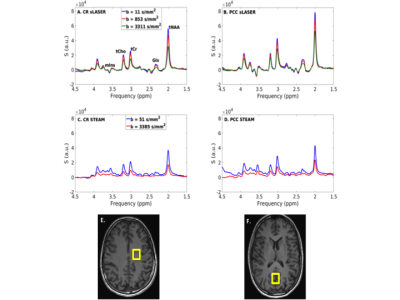 |
 Reproducibility and clinical feasibility of diffusion-weighted MRS using sLASER and STEAM in the human brain in vivo at 3T Reproducibility and clinical feasibility of diffusion-weighted MRS using sLASER and STEAM in the human brain in vivo at 3T
Guglielmo Genovese, Lydia Yahia Cherif, Malgorzata Marjanska, Edward Auerbach, Romain Valabrègue, Itamar Ronen, Stéphane Lehéricy, Francesca Branzoli
Diffusion-weighted MR spectroscopy (DW-MRS) allows disentanglement of different pathological mechanisms of brain tissue by exploiting the specific compartmentation of metabolites in different cell types. In this study, we estimated the reproducibility of metabolite diffusion measures obtained using DW-sLASER and DW-STEAM sequences at 3T. The inter- and intra-subject variability of the apparent diffusion coefficients (ADC) of the three major metabolites, as well as the effect of the acquisition time on the variance of these measures were calculated for both sequences in two brain regions. Power calculations were performed to facilitate the choice of the optimal protocol for specific clinical needs.
|
09:36
|
1065.
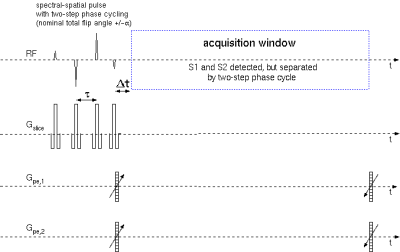 |
 Direct signal detection of exchangeable protons of metabolites with high SNR using ultrashort-TE, short-TR 1-H MRSI without water presaturation Direct signal detection of exchangeable protons of metabolites with high SNR using ultrashort-TE, short-TR 1-H MRSI without water presaturation
Wolfgang Dreher, Felizitas Wermter
Chemical exchange saturation transfer (CEST) is a powerful technique for inverse metabolic imaging and non-invasive pH measurements, and is most efficient in the intermediate exchange regime between protons of metabolites and water. We examined the use of ultrashort-TE, short-TR MRSI for the direct signal detection of exchangeable protons of metabolites. If water is not saturated, fresh z-magnetization is transferred to the protons of metabolites, allowing a high SNR despite short TR. This approach was evaluated by simulations and measurements on creatine phantoms using solutions with different pH, demonstrating direct signal detection for exchange rates up to ~1000 s-1.
|
09:48
|
1066.
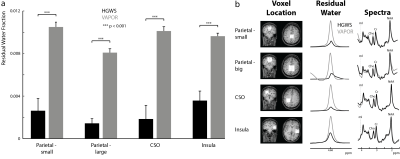 |
 Water suppression in the human brain with hypergeometric RF pulses for single- and multi- voxel MR spectroscopy Water suppression in the human brain with hypergeometric RF pulses for single- and multi- voxel MR spectroscopy
Kimberly Chan, Ronald Ouwerkerk, Peter Barker
In this study, a novel water suppression sequence with hypergeometric RF pulses (HGWS) is investigated and compared to the commonly used VAPOR sequence in simulations, single and multi- voxel acquisitions. In simulations, HGWS and VAPOR are insensitive to B1 and water T1 variations, but with no B1 variation, HGWS has a lower average residual water fraction than that of VAPOR. In vivo, HGWS provides better water suppression than VAPOR in both single-voxel and multi-voxel acquisitions with a shorter sequence duration.
|
|












